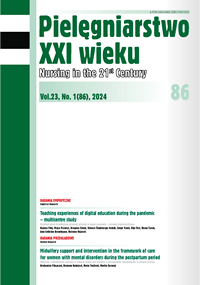The perception of ageism from the perspective of different professions
DOI:
https://doi.org/10.2478/pielxxiw-2024-0013Keywords:
ageism, helping professions, attitudes, non-helping professionsAbstract
THE PERCEPTION OF AGEISM FROM THE PERSPECTIVE OF DIFFERENT PROFESSIONS
Aim. The aim of the study was to compare the diff erences between young people’s perceptions of ageism in terms of professions: helping professions and non-helping professions.
Material and methods. We collected data by the Fraboni Ageism Scale. Cronbach α represented a value of 0.87. We performed statistical processing in SPSS 25.0 and used the t-test and Pearson correlation coeffi cient. The data collection of the entire research sample lasted from December 2020 to March 2021. Our fi nal research group consisted of 262 respondents (HP and NHP). The selection criteria were the consent of each respondent, affi liation to the faculty and the age limit of 18 years and over.
Results. HP are more inclined to help others and elderly. They have a greater degree of tolerance for older adults than NHP, which is confirmed by our results (the D2: Behavior attitudes; p=0.000 and in the D3: Affective attitudes; p=0.000)).
Conclusions. For university students in preparation for their future profession, we can fundamentally infl uence their cognitive, aff ective and behavioral components of the perception of seniors. For these reasons, the evaluation of the perception of stereotypes (D1), separation (D2) and aff ective attitudes (D3) among students of diff erent fields was important.
References
1. Bóriková I. Demografické a zdravotné aspekty starnutia populácie. 2016. Multimediálna podpora výučby klinických a zdravotníckych disciplín: Portál JFUK Available from: https://portal.jfmed.uniba.sk//clanky.php?aid=349
2. Šprocha B. Demografická budúcnosť EÚ v prognózach Eurostatu. Slovenská štatistika a demografia. 2019; 29(2): 48-65. Available from: https://ssad.statistics.sk/SSaD/ index.php/demografi cka-buducnost-eu-v-prognozach-eurostatu/
3. Vavříková H, Hudecová A. Ageismus jako projev stereotypizace a diskriminace seniorů a možnosti jeho prevence prostřednictvím edukace dospělých. Banská Bystrica: Univerzita Mateja Bela v Banskej Bystrici: Belianum; 2018, p. 404.
4. Hwang TJ, Rabheru K, Peisah C, et al. Loneliness and social isolation during the COVID-19 pandemic. Int. Psychogeriatr. 2020; 32(10): 1217-1220. doi:10.1017/ S1041610220000988.
5. Fraboni M, Saltstone R, Hughes S. The Fraboni Scale of Ageism (FSA): An Attempt at a More Precise Measure of Ageism. Canadian Journal on Aging/La Revue Canadienne Du Vieillissement. 1990; 9(1): 56-66. doi:10.1017/S0714980800016093
6. Fan JY, Zhao HM, Liu YT, et al. Psychometric properties of a Chinese version of the Fraboni scale of ageism: evidence from medical students sample. BMC Med Educ 2020; 20(1): 182-197. Available from: https://doi.org/10.1186/s12909-020-02111-7
7. Kane MN, Jacobs RJ. Assumptions about Frailty and the Tenacity of Ageism among Care Professionals. Journal of Pastoral Care & Counseling. 2018; 72(3): 190-194. doi:10.1177/1542305018788527.
8. Chang ES, Kannoth S, Levy S, et al. Global reach of ageism on older persons’ health: A systematic review. PLoS One. 2020; 15(1). Available from: https://doi:10.1371/ journal.pone.0220857.
9. Officer A, de la Fuente-Núñez V. A global campaign to combat ageism. Bull World Health Organ. 2018; 96(4): 295-296. doi: 10.2471/BLT.17.202424.
10. Shpakou A, Klimatckaia L, Kuzniatsou A, et al. Medical care and manifestations of ageism in healthcare institutions: opinion of elderly people. The example of four countries. Fam Med Prim Care Rev 2021;23(1):69–74,doi: https://doi.org/10.5114/ fmpcr.2021.103159
11. Hoozová J. Starnutie a starobné zmeny organizmu. Interná med. 2014;14(5):203–209.
12. Koc A, Inkaya BV, Bilgehan T. Evaluation of the relation between age discrimination and intercultural sensitivities of university students in healthcare fields. Ageing Int 2021; 46: 129-141. Available from: https://doi.org/10.1007/s12126-020-09374-x
13. Burnes D, Sheppard C, Henderson CR Jr, et al. Interventions to Reduce Ageism Against Older Adults: A Systematic Review and Meta-Analysis. Am. J. Public Health. 2019; 109(8): 1-9. doi: 10.2105/AJPH.2019.305123.
14. Flores-Sandoval C, Kinsella EA. Overcoming ageism: critical reflexivity for gerontology practice, Educational Gerontology. 2020; 46(4): 223-234. doi: 10.1080/03601277.2020.1726643.
15. Zhao H, Wu B, Shi J, et al. Chinese Medical Students’ Attitudes toward Older Adults and Willingness To Consider a Career in Geriatric Medicine: A Cross-Sectional Survey. Teach Learn Med. 2020; 32(5): 486-493. doi: 10.1080/10401334.2020.1784739.
16. Chesser AK, Keene Woods N, Smothers K, et al. Health Literacy and Older Adults: A Systematic Review. Gerontol. Geriatr. Med. 2016; 15(2): doi:10.1177/2333721416630492.
17. Gutiérrez M, Mayordomo T. Age discrimination: a comparative study among university students. Acta Colombiana de Psicología. 2019; 22(2): 62-69. Available from: doi: http://www.doi.org/10.14718/ACP.2019.22.2.4
18. Choolayil AC, Putran L. Ageism among Undergraduate Students: Do Grandparents make a Difference? Indian Journal of Gerontology. 2020; 34(3): 333-342.
Downloads
Published
Issue
Section
License
Copyright (c) 2024 Authors

This work is licensed under a Creative Commons Attribution 4.0 International License.




